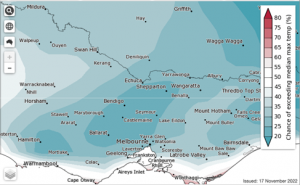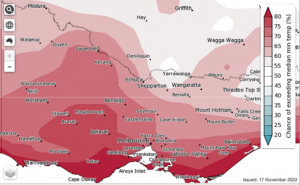This information has been commissioned by the Goulburn Murray Valley Area Wide Management Fruit Fly Program and is funded by the Victorian Government. Use of this material in its complete and original format, acknowledging its source, is permitted, however unauthorised alterations to the text or content is not permitted.
Summer fruit fly activity
Fruit fly activity will continue to increase as we move from the spring peak and start to experience population increases which will build over summer. Increased fruit fly across the Goulburn Murray Valley are adult flies that were able to survive the winter by over wintering. The next generation of flies will emerge from eggs laid by these overwintering flies. Queensland fruit fly numbers will continue to steadily increase over the summer months until April 2023, with a small decline typically experienced during January when very hot, dry weather occurs. Home gardeners, property owners and growers should be fruit fly ready as we enter the peak growing season.
Fruit fly management programs and strategies in place now and followed throughout the season will keep fruit fly activity under control. The importance of whole-of-community ownership awareness and participation cannot be understated in working to reduce the spread of Queensland fruit fly.
Weather trends favourable for fruit fly
Weather conditions throughout 2022 have been favourable for fruit fly. The Goulburn Murray Valley was wetter and more humid than usual, with more rainfall, less evaporation and lower solar radiation. Maximum temperatures were relatively normal except for September and October. Minimum temperatures were relatively normal. This type of weather pattern benefits survival and population expansion of fruit fly in the region.
FIG. 1. RAINFALL

The chance of exceeding the median monthly rate of rainfall for the GMV (10mm to 25mm in the north of the Goulburn Murray Valley and 25mm to 50mm in the south) is 60% to 65%. This indicates a likely increase above the average in rainfall for the region in December 2022.
FIG. 2. MAXIMUM TEMPERATURE

The chance of maximum daily temperatures in the Goulburn Murray Valley being higher than the median (30˚C to 33˚C in the north of the Goulburn Murray Valley and 27˚C to 30˚C in the south) is 20% to 30%. This means that maximum daily temperatures in the region are likely to be lower than usual during December 2022.
FIG. 3. MINIMUM TEMPERATURE

The chance of minimum daily temperatures in the Goulburn Murray Valley being higher than the median (12˚C to 15˚C) is 60% to 70%. This means that minimum daily temperatures in the region are likely to be higher than usual during December 2022.
Fruit fly hot spots
A number of locations have been identified as sites of concern through the Goulburn Murray Valley regional trapping grid. If you live in or near these locations, place monitoring traps out and check nearby ripening, ripe or overripe fruit for the presence of fruit fly. Locations requiring extra vigilance include:
| Cobram |
| Mooroopna |
| Kyabram |
| Shepparton |
| Tatura |
| Merrigum |
*It should be noted that some flies trapped in Cobram urban may be previously released sterile fruit fly that have survived winter.
Impact of flooding on Queensland fruit fly
Recent flooding across the region caused difficulties in accessing fruit fly traps. Traps are normally visited each week at this time of year to provide an indication of fruit fly presence and build-up, however flooding impacted this in some areas.
Floods have little impact on fruit flies. In fact, they may benefit in some ways. For example, very wet weather will cause significant increases in relative humidity and, as a result, bacterial, fungal and yeast growth. These organisms are feed for adult fruit flies. Warm daily minimum temperatures associated with wet weather also favour the survival of adult fruit flies as well as eggs, larvae and pupae.
Queensland fruit fly eggs and larvae are susceptible to immersion in water, being killed in a matter of hours. If the water is shallow (less than 1cm deep) eggs and larvae may survive for over 24 hours. If eggs and larvae are inside infested fruit that has fallen on to the ground and are then flooded it will take several days (as many as 5 days) before water will penetrate fruit to impact eggs and larvae. In effect, flooding for fewer than 5 days will not impact egg and larval survival adversely.
Pupae are tolerant of flooding. Firstly they may float to the surface and then move to the edge of the water mass and survive as per normal. If forcibly immersed, pupae will survive for many hours. Laboratory experiments with pupae stored 10cm under water at 26˚C showed that 48% survived 3 days submersion and 7% survived 7 days under water. It was estimated that to achieve 100% mortality Queensland fruit fly pupae would need to be held under water for more than 8 days.
Adult flies are quite susceptible to being wet (i.e. caught in the rain). If the adult fly is sprayed with water the fly becomes immobile as the water sticks its wings together or to the surface on which the fly is resting. If this lasts for some time the insect becomes prey to birds, reptiles and other predatory insects. Sometimes, stuck flies die of starvation unless the weather warms up and dries them out. However, Queensland fruit fly have a very significant survival instinct and are well able to move away from falling water and into protective coverage.
Goulburn Murray Valley Area Wide Management Fruit Fly Program
For assistance in managing fruit fly, contact the Project Coordinator at the Goulburn Murray Valley Fruit Fly Office by phoning (03) 5871 9222 or email gmvfruitfly@moira.vic.gov.au.
This report was produced and supplied by Janren Consulting Pty Ltd for the purpose of the Goulburn Murray Valley Fruit Fly Program. The Goulburn Murray Valley Fruit Fly Area Wide Management Program is supported by the Victorian Government.
